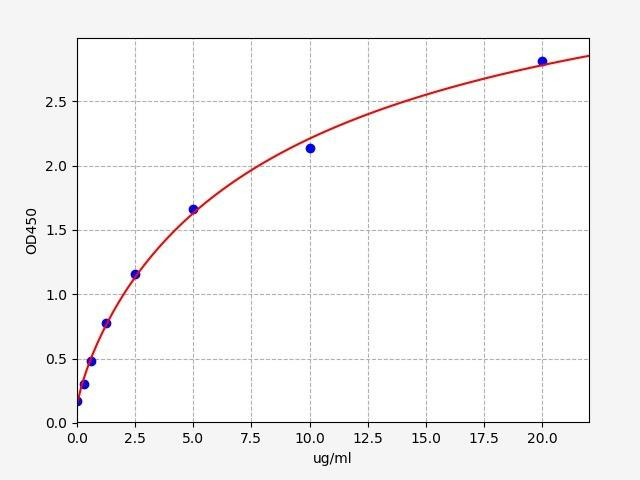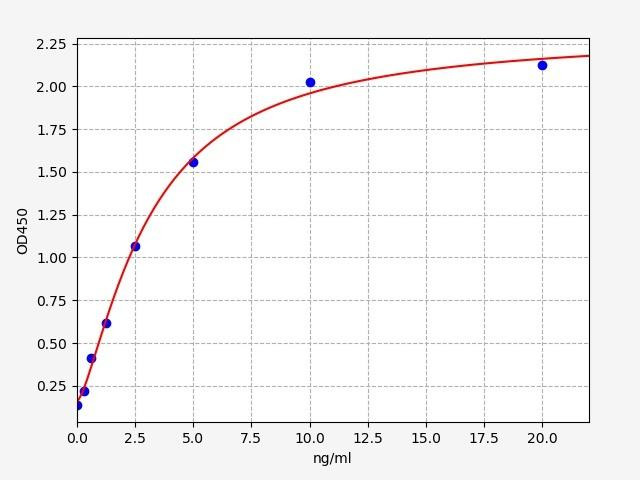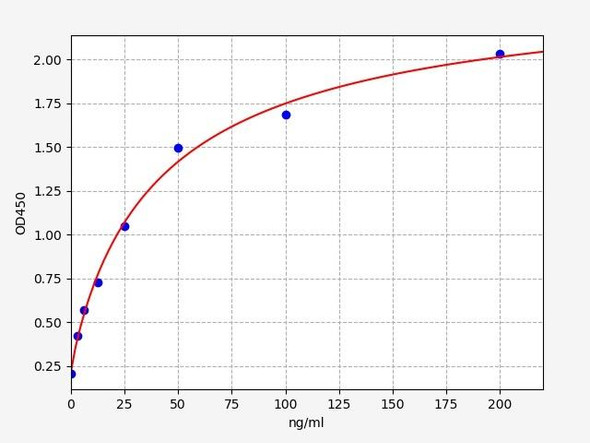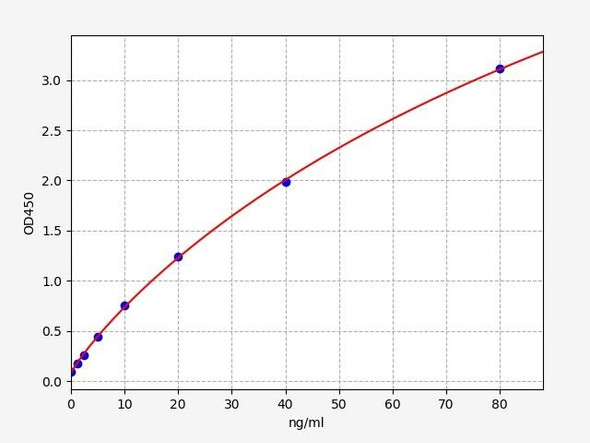Mouse Apolipoprotein E / APOE ELISA Kit
- SKU:
- MOFI00648
- Product Type:
- ELISA Kit
- Size:
- 96 Assays
- Uniprot:
- P08226
- Sensitivity:
- 0.938ng/ml
- Range:
- 1.563-100ng/ml
- ELISA Type:
- Sandwich
- Synonyms:
- APO-E, Apolipoprotein E, Apo-E, MGC1571, apolipoprotein E3
- Reactivity:
- Mouse
- Research Area:
- Cell Biology
Description
Mouse Apolipoprotein E / APOE ELISA Kit
APOE is a vital protein involved in lipid metabolism and transportation, playing a crucial role in maintaining lipid homeostasis and clearance. This high-quality ELISA kit provides a reliable and sensitive method to accurately quantify APOE levels in mouse serum, plasma, and other biological samples, enabling researchers in understanding the role of APOE in various physiological and pathological processes, such as cardiovascular diseases, neurodegeneration, and lipid-related disorders.
Key Features
| Save Time | Pre-coated 96 well plate | |
| Quick Start | Kit includes all necessary reagents | |
| Publication Ready | Reproducible and reliable results |
Overview
| Product Name: | Mouse Apolipoprotein E / APOE ELISA Kit |
| Product Code: | MOFI00648 |
| Size: | 96 Assays |
| Alias: | APO-E, Apolipoprotein E, Apo-E, MGC1571, apolipoprotein E3 |
| Detection Method: | Sandwich ELISA |
| Application: | This immunoassay kit allows for the in vitro quantitative determination of Mouse APO-E concentrations in serum plasma and other biological fluids. |
| Sensitivity: | 0.938ng/ml |
| Range: | 1.563-100ng/ml |
| Storage: | 4°C for 6 months |
| Note: | For Research Use Only |
Additional Information
| Recovery | Matrices listed below were spiked with certain level of Mouse APO-E and the recovery rates were calculated by comparing the measured value to the expected amount of Mouse APO-E in samples.
| ||||||||||||||||||||
| Linearity: | The linearity of the kit was assayed by testing samples spiked with appropriate concentration of Mouse APO-E and their serial dilutions. The results were demonstrated by the percentage of calculated concentration to the expected.
| ||||||||||||||||||||
| CV(%) | Intra Assay <8 Inter Assay <10 |
Kit Components
| Component | Quantity | Storage |
| ELISA Microplate (Dismountable) | 8x12 strips | 4°C for 6 months |
| Lyophilized Standard | 2 | 4°C/ -20°C |
| Sample/Standard Dlution Buffer | 20ml | 4°C |
| Biotin-labeled Antibody (Concentrated) | 120ul | 4°C (Protection from light) |
| Antibody Dilution Buffer | 10ml | 4°C |
| HRP-Streptavidin Conjugate (SABC) | 120ul | 4°C (Protect from light) |
| SABC Dilution Buffer | 10ml | 4°C |
| TMB Substrate | 10ml | 4°C (Protection from light) |
| Stop Solution | 10ml | 4°C |
| Wash Buffer (25X) | 30ml | 4°C |
| Plate Sealer | 5 | - |
Other materials required:
- Microplate reader with 450 nm wavelength filter
- Multichannel Pipette, Pipette, microcentrifuge tubes and disposable pipette tips
- Incubator
- Deionized or distilled water
- Absorbent paper
- Buffer resevoir
Protocol
*Note: Protocols are specific to each batch/lot. For the exact instructions please follow the protocol included in your kit.
Before adding to wells, equilibrate the SABC working solution and TMB substrate for at least 30 min at 37°C. When diluting samples and reagents, they must be mixed completely and evenly. It is recommended to plot a standard curve for each test.
| Step | Procedure |
| 1. | Set standard, test sample and control (zero) wells on the pre-coated plate respectively, and then, record their positions. It is recommended to measure each standard and sample in duplicate. Wash plate 2 times before adding standard, sample and control (zero) wells! |
| 2. | Aliquot 0.1ml standard solutions into the standard wells. |
| 3. | Add 0.1 ml of Sample / Standard dilution buffer into the control (zero) well. |
| 4. | Add 0.1 ml of properly diluted sample ( Human serum, plasma, tissue homogenates and other biological fluids.) into test sample wells. |
| 5. | Seal the plate with a cover and incubate at 37 °C for 90 min. |
| 6. | Remove the cover and discard the plate content, clap the plate on the absorbent filter papers or other absorbent material. Do NOT let the wells completely dry at any time. Wash plate X2. |
| 7. | Add 0.1 ml of Biotin- detection antibody working solution into the above wells (standard, test sample & zero wells). Add the solution at the bottom of each well without touching the side wall. |
| 8. | Seal the plate with a cover and incubate at 37°C for 60 min. |
| 9. | Remove the cover, and wash plate 3 times with Wash buffer. Let wash buffer rest in wells for 1 min between each wash. |
| 10. | Add 0.1 ml of SABC working solution into each well, cover the plate and incubate at 37°C for 30 min. |
| 11. | Remove the cover and wash plate 5 times with Wash buffer, and each time let the wash buffer stay in the wells for 1-2 min. |
| 12. | Add 90 µl of TMB substrate into each well, cover the plate and incubate at 37°C in dark within 10-20 min. (Note: This incubation time is for reference use only, the optimal time should be determined by end user.) And the shades of blue can be seen in the first 3-4 wells (with most concentrated standard solutions), the other wells show no obvious color. |
| 13. | Add 50 µl of Stop solution into each well and mix thoroughly. The color changes into yellow immediately. |
| 14. | Read the O.D. absorbance at 450 nm in a microplate reader immediately after adding the stop solution. |
Sample Preparation
When carrying out an ELISA assay it is important to prepare your samples in order to achieve the best possible results. Below we have a list of procedures for the preparation of samples for different sample types.
| Sample Type | Protocol |
| Serum | If using serum separator tubes, allow samples to clot for 30 minutes at room temperature. Centrifuge for 10 minutes at 1,000x g. Collect the serum fraction and assay promptly or aliquot and store the samples at -80°C. Avoid multiple freeze-thaw cycles. If serum separator tubes are not being used, allow samples to clot overnight at 2-8°C. Centrifuge for 10 minutes at 1,000x g. Remove serum and assay promptly or aliquot and store the samples at -80°C. Avoid multiple freeze-thaw cycles. |
| Plasma | Collect plasma using EDTA or heparin as an anticoagulant. Centrifuge samples at 4°C for 15 mins at 1000 × g within 30 mins of collection. Collect the plasma fraction and assay promptly or aliquot and store the samples at -80°C. Avoid multiple freeze-thaw cycles. Note: Over haemolysed samples are not suitable for use with this kit. |
| Urine & Cerebrospinal Fluid | Collect the urine (mid-stream) in a sterile container, centrifuge for 20 mins at 2000-3000 rpm. Remove supernatant and assay immediately. If any precipitation is detected, repeat the centrifugation step. A similar protocol can be used for cerebrospinal fluid. |
| Cell culture supernatant | Collect the cell culture media by pipette, followed by centrifugation at 4°C for 20 mins at 1500 rpm. Collect the clear supernatant and assay immediately. |
| Cell lysates | Solubilize cells in lysis buffer and allow to sit on ice for 30 minutes. Centrifuge tubes at 14,000 x g for 5 minutes to remove insoluble material. Aliquot the supernatant into a new tube and discard the remaining whole cell extract. Quantify total protein concentration using a total protein assay. Assay immediately or aliquot and store at ≤ -20 °C. |
| Tissue homogenates | The preparation of tissue homogenates will vary depending upon tissue type. Rinse tissue with 1X PBS to remove excess blood & homogenize in 20ml of 1X PBS (including protease inhibitors) and store overnight at ≤ -20°C. Two freeze-thaw cycles are required to break the cell membranes. To further disrupt the cell membranes you can sonicate the samples. Centrifuge homogenates for 5 mins at 5000xg. Remove the supernatant and assay immediately or aliquot and store at -20°C or -80°C. |
| Tissue lysates | Rinse tissue with PBS, cut into 1-2 mm pieces, and homogenize with a tissue homogenizer in PBS. Add an equal volume of RIPA buffer containing protease inhibitors and lyse tissues at room temperature for 30 minutes with gentle agitation. Centrifuge to remove debris. Quantify total protein concentration using a total protein assay. Assay immediately or aliquot and store at ≤ -20 °C |
| Breast Milk | Collect milk samples and centrifuge at 10,000 x g for 60 min at 4°C. Aliquot the supernatant and assay. For long term use, store samples at -80°C. Minimize freeze/thaw cycles. |
Apolipoprotein e (APO-3) Background
What is Apolipoprotein e?
Apolipoproteins are a group of proteins that play a crucial role in lipid metabolism by binding to lipids and forming complexes known as lipoproteins. These lipoprotein particles transport lipids, including cholesterol and triglycerides, through the bloodstream.
ApoE is a multifunctional protein involved in the transport and redistribution of lipids, especially cholesterol and triglycerides. It interacts with lipoprotein particles, primarily high-density lipoproteins (HDL), very low-density lipoproteins (VLDL), and chylomicrons.
Apolipoprotein e Gene
The gene encoding apolipoprotein E is called APOE, and it is located on chromosome 7 in mice and chromosome 19 in humans. The APOE gene has three common alleles: APOE2, APOE3, and APOE4. These alleles differ by two single nucleotide polymorphisms (SNPs) at positions 112 and 158 of the gene.
Apolipoprotein e Structure
ApoE is a 34-kDa protein composed of 299 amino acids. It consists of two major structural domains: an N-terminal domain and a C-terminal domain. These domains are connected by a flexible hinge region. The N-terminal domain is responsible for binding to lipids and receptors, while the C-terminal domain is involved in protein-protein interactions.
Apolipoprotein e Function
ApoE is a multifunctional protein involved in the transport and redistribution of lipids, especially cholesterol and triglycerides. It is primarily involved in lipid metabolism and lipoprotein transport. It plays a crucial role in the clearance of lipoproteins from the bloodstream, and interacts with lipoprotein particles, primarily high-density lipoproteins (HDL), very low-density lipoproteins (VLDL), and chylomicrons. It shows preferential binding to HDL. It also interacts with specific receptors on the surface of liver cells and other tissues. ApoE facilitates the uptake of lipoprotein particles by these Apoe receptors, leading to their degradation and subsequent lipid removal.
In addition, APOE can also bind to heparan-sulfate proteoglycans on the surface of cells, a property that supports the capture and the receptor-mediated uptake of APOE-containing lipoproteins by cells
Apolipoprotein e variants/isoforms
There are six major APOE genotypes in humans - three homozygous (APOE2/2, APOE3/3 and APOE4/4), and three heterozygous (APOE2/3, APOE2/4 and APO3/4).
Out of the alleles, globally, the APOE3 allele is most common (79%), followed by E4 (15%) and E2 (7%), and these differences occur due to synonymous SNPs at exon 4 of the APOE gene.
APOE and Alzheimer's disease
The APOE gene polymorphisms, specifically APOE4 allele, have been extensively studied due to their association with various diseases.The APOE4 (apolipoprotein e4) allele is a major genetic risk factor for late-onset Alzheimer's disease (AD), with individuals carrying one or two copies of APOE4 having an increased susceptibility to developing AD. Additionally, the APOE4 allele is also associated with increased risk and poorer outcomes in cardiovascular diseases, such as atherosclerosis and coronary artery disease. On the other hand, the APOE2 allele has been linked to potential protective effects against cardiovascular diseases and Alzheimer's disease.
Mouse APOE ELISA Kit FAQs
Q: What is the purpose of the MOUSE APO3 ELISA kit?
The MOUSE APO3 ELISA kit is designed for the quantitative measurement of apolipoprotein E (ApoE) levels in mouse serum, plasma, and other biological samples. It allows researchers to study the expression and levels of ApoE in various experimental settings.
Q: What type of samples can be used with the MOUSE APO3 kit?
The Mouse APOE ELISA Kit is optimized for the measurement of ApoE levels in mouse serum and plasma samples. However, it may also be used with other mouse biological fluids or tissue lysates that contain ApoE. Please refer to the kit's manual for sample preparation instructions.
Q: Is the MOUSE APO3 ELISA kit compatible with other species?
No, this particular kit is designed specifically for the measurement of mouse ApoE. For other species, such as human, there are separate ELISA kits available that are optimized for those specific samples.
Q: Where can I find additional technical support or assistance with the MOUSE APO3 ELISA kit?
For any technical inquiries or assistance regarding the Mouse APOE kit, you can reach out to our team. They will be available to answer your questions and provide the necessary guidance to ensure a successful experiment.
Related Products

| Mouse APOA1 ELISA Kit | |
|---|---|
| ELISA TYPE: | Sandwich ELISA, Double Antibody |
| SENSITIVITY: | 4.688ng/ml |
| RANGE: | 7.813-500ng/ml |

| Mouse ApoB / Apolipoprotein B ELISA Kit | |
|---|---|
| ELISA TYPE: | Sandwich ELISA, Double Antibody |
| SENSITIVITY: | 0.188ug/ml |
| RANGE: | 0.313-20ug/ml |

| Mouse APOC4 ELISA Kit | |
|---|---|
| ELISA TYPE: | Sandwich ELISA, Double Antibody |
| SENSITIVITY | 0.188ng/ml |
| RANGE: | 0.313-20ng/ml |








